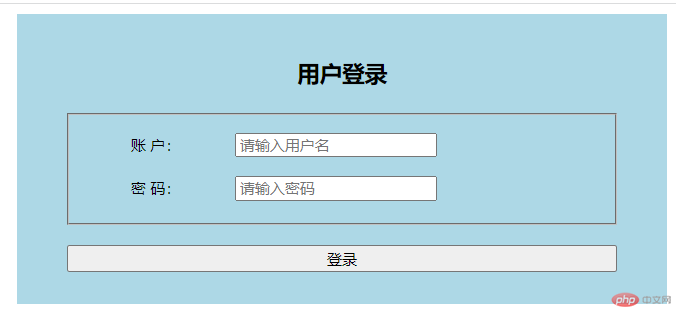显示用户登录代码 login.html
<!DOCTYPE html><html lang="en"> <head> <meta charset="UTF-8" /> <meta http-equiv="X-UA-Compatible" content="IE=edge" /> <meta name="viewport" content="width=device-width, initial-scale=1.0" /> <title>用户登录</title> <style> .login { width: 480px; margin: 0 auto; padding: 20px; background-color: lightblue; } form { display: grid; gap: 0.5rem; } form * { margin: 5px 20px; } h2 { text-align: center; } </style> </head> <body> <div class="login"> <h2>用户登录</h2> <form action=""> <fieldset> <div> <label for="account">账 户:</label> <input type="text" id="account" name="account" required placeholder="请输入用户名" /> </div> <div> <label for="password">密 码:</label> <input type="password" id="password" name="password" required placeholder="请输入密码" /> </div> </fieldset> <button type="button" onclick="check(this.form)">登录</button> </form> </div> <script> function check(thisForm) { const account = thisForm.account.value.trim(); const password = thisForm.password.value.trim(); //加密成JSON数据 const user = JSON.stringify({ account: account, password: password }); fetch("check.php", { method: "post", body: user }) .then((response) => response.json()) .then((json) => { if (json.status != 0) { alert(json.msg); return false; } alert(json.msg); setTimeout(() => { window.location.href = "showuser.php"; }, 1000); }); } </script> </body></html>

<?phprequire_once "auto.php";session_start();header("Content-Type:application/json");$data=trim(file_get_contents('php://input'));// json 转为数组$user=json_decode($data,true);//$res=UserContr::login($user['account'],$user['password']);if($res['stutas']==0){ setcookie('id',1); $_SESSION['account']=$user['account'];}echo json_encode($res);
- UserContr.php文件UserContr类中的用户登录代码
//用户登录 public static function login($account,$password){ $pdo =CreatePDO::Create(); $sql="SELECT * FROM `php_user` WHERE account='".$account."'"; $pre=$pdo->prepare($sql); $exec=$pre->execute(); $arr=$pre->fetch(); if(empty($arr)){ $res=['status'=>1,'msg'=>'用户不存在']; }elseif($arr['password']!=md5($password)){ $res=['status'=>2,'msg'=>'密码不正确']; }else{ $res=['status'=>0,'msg'=>'登录成功']; } return $res; }
<?phpsession_start();if(empty($_COOKIE['id'])){ echo "<script>window.location.href='login.html'</script>"; exit;}$account=$_SESSION['account'];?><div class="header"><div><span><?=$account?></span> <a href="destroy.php">注销</a></div></div><style> *{ margin: 0; padding: 0; } .header{ height: 30px; background-color: purple; } .header div{ width: 15em; margin:5px 0px ; position: fixed; right: 2px; color: lightsalmon; } a{ text-decoration: none; } .header a{ margin:auto 1rem; color: #eee; }</style>
- 在showuser.php文件中引入header.php文件。
<?php require_once "header.php" ?>

<?phpsetcookie('id',1,time());$_SESSION['account']=null;echo '<script>alert("退出登录");location.href="login.html"</script>';

